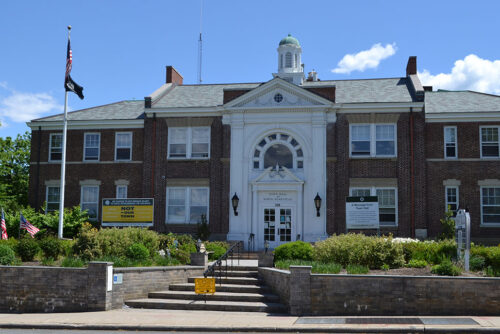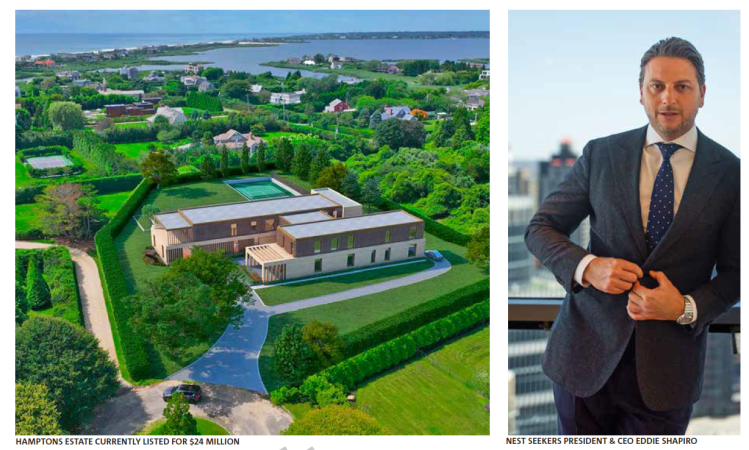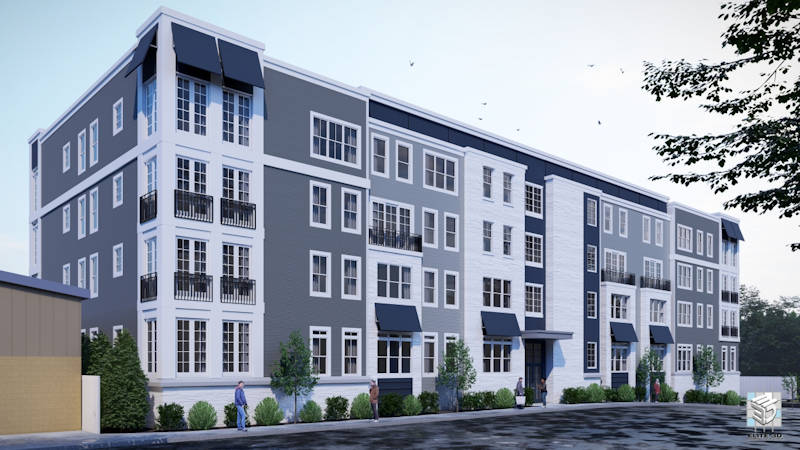
“Your village checks every box that we are looking for,” said the developer. “We’ve been trying to work here for quite some time, so we’re thrilled to be here.”
Those were words that Westbury village leaders wanted to hear. On Aug. 19, they got a preview of the first of what they hope will be the first many projects that will transform Westbury’s railroad district.
Developer Anthony Bartone, manager partner of Terwilliger & Bartone Properties of Farmingdale, has a track record of building transit-oriented developments in flourishing downtowns. He and his team made a presentation before the Village of Westbury Board of Trustees.
His company is proposing to build a $24 million, 72-unit, four-story apartment complex at the property defined by the corners of Union Avenue, Railroad Avenue and School Street. It will be named Cornerstone at Westbury. The 32,370-square foot parcel is currently occupied by Krystal Produce, a food handling warehouse. Bartone told the Westbury Times that his company is in the process of completing the purchase.
It will consist of three “microunits,” 29 studios, 36 one-bedroom and four two-bedroom apartments.

“It’s been our experience that in a transit-oriented environment the studio units, or the one-bedroom units, are in very, very high demand,” Bartone explained. “Not to say that the two’s are not, but we find that those are where the highest demand lies. And further, we find that the microunits and the studios are, as you might say, attainable by design in that since there is less square footage the rents are commensurate with that square footage, and hence, more affordable to a broader group.”
Under the old zoning, the area was mainly zoned industrial. But in 2016, Westbury became the first community on Long Island to garner the $10 million Downtown Revitalization Initiative (DRI) grant from New York State. Part of the money was used to revamp the village code to encourage transit-oriented development in a 50-plus-acre area surrounding the train station. It was renamed the Maple Union Transit-Oriented Development (TOD) Zone.
Mayor Peter Cavallaro called Bartone’s application the “beginning of the coming to fruition” of the rezoning of the area that was codified in December 2019, “and that the project, as the first one, will hopefully spur other projects in the target area.” He added that “we had several preliminary meetings with the applicant, had certain additional information provided to us and some changes made to the plans that were ultimately submitted for the hearing.”

Bartone told the board, “Investment encourages investment. Revitalization encourages revitalization,” adding that his project would be a spark for further developments in the new mixed-use zoning area.
“We’ve been attracted to the village as a whole, given its downtown and its mass transit,” Bartone told the Westbury Times, adding that the property to be developed—about 1,000 feet from the train station—was a natural fit. “It’s arguably way underutilized as a warehouse and this is a higher and better use. All of which we thought would be attractive,” he added.
Bartone said that his firm was aware of the zoning change wrought by the DRI.
“We monitored that closely and were at a number of public hearings,” he told the Times. “We certainly applaud the mayor and the board for the steps they took. It was a long process and they did a great job.”
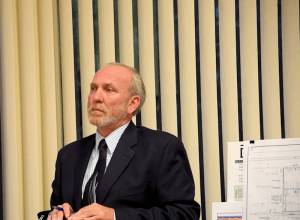
The developer said a major underlying assumption of transit-oriented housing is that its inhabitants want to live within walking distance to the train and commute to work in the city.
“Yes, that does exist,” he went on. “But we found, and this was pre-COVID, so the world is redefining itself, but we found that the overwhelming number of our residents chose to live there not for work, but for the social amenities aspect of it. When they go out, it’s actually more important for them [to go downtown].”
Further, according to Bartone, “Studies show that a household will typically spend 40 percent of their income on discretionary spending. Now, we’re not trying to say that all 40 percent of that income will be deployed in the downtown, but certainly you can say that a meaningful portion of that will be. So there is discretionary spending being introduced into the downtown to help support our merchants who have certainly had their share of struggles over the past couple of years.”
To a question from Trustee Vinny Abbatiello about sound mitigation, being that the property is adjacent to the railroad tracks, Bartone replied, “The building, we’ve consulted with numerous acoustical engineers, who are very sound sensitive, so the building will be built with 6-inch walls, resilient channels, high density insulations, triple-glazed windows, and alike, all to mitigate any sound or vibration coming from the train. Again, I mention that because we’re not novices with it, fortunately, it’s a niche that we embrace.”
No Rats Here
You will not see “Scabby the Rat” at a Bartone site. The inflatable rat is placed by unions at construction sites using non-union labor.
“This project will generate a number of local construction jobs,” Bartone told the board. “At Bartone properties we are proud of the fact that we enjoy very strong relationships with organized labor.”
He introduced Tim McCarthy from IBEW Local 25, representing electrical workers.

“Bartone has been a great industry partner,” McCarthy affirmed. “They do the right thing in their community and they pay their bills, which in our industry is pretty important. We’re the electricians for Nassau and Suffolk County, so we are the hyperlocal workforce for this job. We have folks that live in Westbury, as a matter of fact.”
Bartone listed a number of different unions that would be on the job, adding that, though its labor force is not 100 percent union, “we have very harmonious sites, we’ve never had a demonstration on our sites.”
“As far as the labor goes, Anthony and I have been, this will be our seventh project together if this moves forward, so we’ve done all our jobs together,” said Michael Maimone, senior project manager for the electrical contractor. “The a job sites of today are not like they were in the ’80s and the ’90s. So it’s a vastly different workforce and a vastly different environment on the projects. Open-shop labor has been more of the norm now for the past 10 years on Long Island then it was back in those days. So I can honestly say in the seven jobs potentially we’re about to do together we have never had any issues on the jobs from any of the trades. And we basically have the same trades that go from one job to the next so it’s the same people.”
Money Talk
The current property, according to county records, paid $62,461 in school and library taxes in 2020-21. County, town and special district taxes totaled $30,800 in 2021.
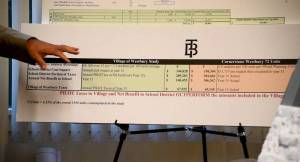
Bartone stated that the warehouse pays $9,647 in village taxes. He estimated that this figure will rise to $52,403 once the apartment is done. He estimated that five or six school-age children will eventually live in the apartments. He put up a board showing the cost for the school to educate these students versus what the finished project would pay in taxes. The conclusion? The net positive to the district will be more than $2 million over 20 years.
“It’s overwhelmingly tax positive to the Westbury School District,” he said.
Bartone said his firm had begun an application with the county’s Industrial Development Agency to receive tax benefits and payments in lieu of taxes (PILOT) for varying taxing districts.
Assuming that the project gets village approval, the goal is to start construction in the first quarter of 2022. It is expected to take about 18 months.
Bartone has designated the Long Island Housing Partnership to manage the lottery for the 10 affordable units in the building. He noted that the Cornerstone Yorkshire in Lynbrook, nearing completion, had 378 applications for its eight affordable units.
Bartone did mention that the firm does sell some of its projects. At least have been bought by Fairfield Properties, oen of the more active multi-family housing companies.
“So what determines whether you keep them or sell them?” the Westbury Times asked Bartone.
“These are expensive assets. They are many millions of dollars,” he replied. “And the slightest movement in interest rates, the evaporation of capital gains treatment or 1031 treatment—any of the above can influence the decision.”
He added, “We have a lot of capital partners involved—banks, etc. There’s a lot that goes into the decision making. And we can never really predict. So we always say that we’re going into it assuming we’re going to keep it, and then we react to market conditions.”
Neighbor’s Concern
Glen Wolther of Syosset owns All Round Foods, next door to the proposed project. He said he was not anti-development, but worried about the new TOD zoning and what it could mean to his business.

“Please let me stay in business,” Wolther told the board. “I’m concerned about that. I choose not to sell my business. I choose not to sell my property because I love what I do. I’ve since learned that I was made an offer to buy my property. My business is worth more running a cold storage warehouse. My property is worth more. I get more money selling it that way. And part of the analysis was economics, so from an economic standpoint I was better off keeping my property than selling it.”
Cavallaro assured him that “there is nothing in our zoning that compels the change of any existing use.”
Abbatiello had raised questions about the traffic and the trucks associated with Wolther’s business and how it might impact Cornerstone residents.
“In my 30 years being on that property I can’t think of one accident from a truck who hit a pedestrian walking down the street,” Wolther stated.
He went on, “Since I do operate a business and there are trucks, what will be done to ensure that the construction vehicles, either the village, or construction vehicles aren’t parked in front of my building so I can’t back in a tractor trailer?”
Wolther noted that he had problems with MTA trucks during the station construction, and needed to call the police regularly to get them moved. He hoped the village would respond to any potential future problems with Cornerstone construction trucks.
“Construction is a pain of the butt,” Bartone admitted. “I’m not going to lie, we do the best we can to keep it controlled, but construction is construction. And there will be trucks. There will be workers. And it will be done in compliance and in lockstep with village ordinances.”
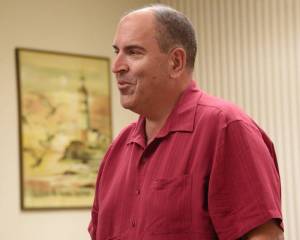
The mayor noted that the village has had issues with the third track construction contractors 3TC “and we have done parking enforcement on them. And I think we have done it even in response to some of your issues, but we would do the same thing here if there are cars parked or trucks parked there illegally, we would enforce the parking law and the traffic law that we have that you can’t park in that part of Railroad Avenue, and he can’t block your driveway, and that would be something that would be a matter of enforcement. So we do take that seriously and we would address that if that was something that was a problem or you think was becoming a problem.”
About The Company
Bartone opened his presentation with the following statement:
Terwilliger & Bartone Properties is a strategic joint venture that was formed in 2015 which is a joint venture between my company, Bartone Properties and the Terwilliger Organization. By way of background, Bartone Properties, we are local real estate developers here on Long Island. We focused exclusively on the Long Island submarket since our inception. The Terwilliger Organization, however, has existed on a national platform for 40 years. Ron Terwilliger, the chairman, has the distinction of being the largest multi-family developer in history. Having developed over 300,000 residential units in 1,200 buildings, spread over 23 offices in his career. He has since retired and now has three joint ventures. We are the northeast joint venture. So with us you get the unique blend of hyper-local boots-on-the-ground expertise, understanding of the culture of Long Island, myself, and my co-managing partner, Fran Terwilliger. And then, of course, the resources and national expertise of our chairman, Ron Terwilliger.
“We’re excited to be here,” Bartone summed up to Times.





